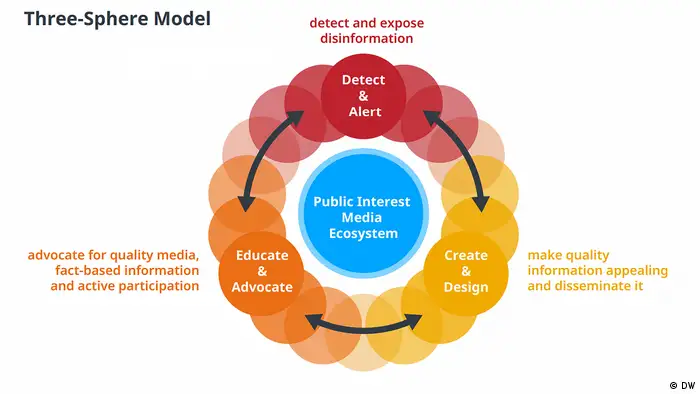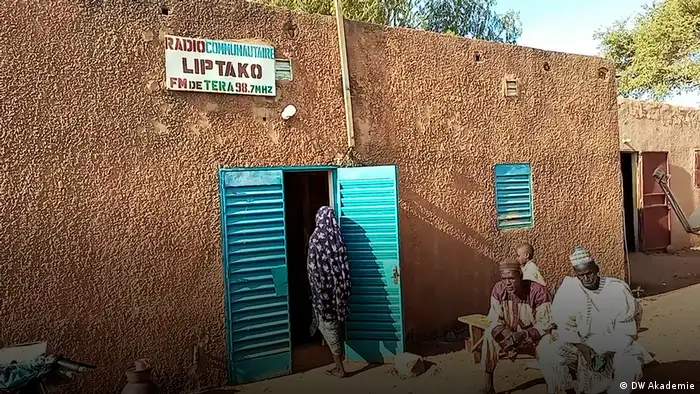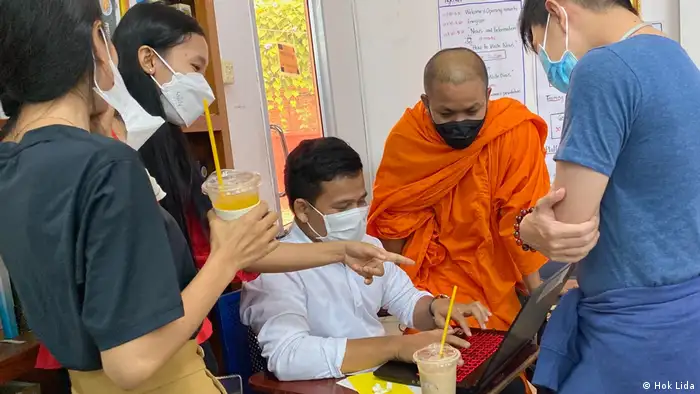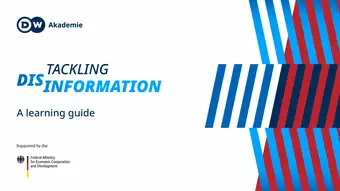Tackling disinformation: A learning guide
Three-sphere model tackles disinformation systematically
DW Akademie has developed a systemic approach to tackle disinformation. Here's how the three-sphere model works and the thinking behind it.
DW Akademie, DW's center for international media development, supports media ecosystems orientated towards the common good/public interest. This strengthens the overall resilience of media ecosystems against disinformation, a correlation that, as is discussed below, has been empirically proven. This systematic approach means that our work is effective against disinformation even when an individual DW Akademie project doesn't specifically have tackling disinformation as a goal.
The resilience of the media ecosystem to disinformation increases as trust in the media rises. UNESCO points out this direct correlation in its 2020 report, Balancing act: countering digital disinformation while respecting freedom of expression:
"... resilience to disinformation is higher in countries where trust in news media is high and public service media provision is strong. Moreover, low public trust in news media and democratic institutions can lead to highly selective information consumption through online echo chambers that amplify disinformation and deepen polarization. Consequently, there is an urgent need to not only address disinformation, but also to take steps towards rebuilding the social contract and public trust in agreed international norms and standards: strengthen democratic institutions; promote social cohesion particularly in highly divided societies; and engage dialogue-building tactics to address entrenched groups and actors online."
Disinformation is a highly complex problem (also called a wicked problem, which you can read more about here). At DW Akademie, we take a holistic approach to tackling disinformation that aims to have an impact in three spheres: Detect & Alert, Design & Create and Educate & Advocate.
Ideally, all our measures directed against disinformation should have an impact in all three spheres. In this way, we cover both the supply and the demand side of disinformation and have an impact in the short, medium and long term.
-
Sphere 1: Detect & Alert (short term) — detect and expose disinformation. Recognize and expose acute disruptions in the media ecosystem and the associated actors, methods and systems
-
Sphere 2: Design & Create (medium to long term) — make quality information appealing and disseminate it
-
Sphere 3: Educate & Advocate (long term) — advocate for quality media, fact-based information and active participation
A comprehensive portfolio of services can be allocated to the three spheres. Ideally, approaches from all spheres are combined in order to develop a sustainable impact:
Sphere 1: Detect & Alert
This sphere aims to recognize and expose actors, methods and systems of disinformation. The focus here is primarily on acute, intentional disruptions to the media ecosystem, and measures should have an immediate and short-term effect.
Concrete approaches include:
-
Fact check: debunking / prebunking
-
Verification: professional and for amateurs (media and information literacy)
-
Moderation of content / deplatforming
-
Investigative research: digital forensics, network analysis, campaign detection, OSINT (Open Source Intelligence) / WEBINT (Web Intelligence)
Questions to ask:
-
How can covert disinformation campaigns be uncovered with tools and research?
-
How does the disinformation economy work (ad systems and influencer networks)?
-
How can the functioning of algorithms be better understood and monitored (algorithm literacy)?
-
How does generative AI affect the field of disinformation?
-
When does social listening make sense?
Project example: PesaCheck in Africa, a verification initiative of Code for Africa
Sphere 2: Create & Design
In Sphere 2, we want to do more than eliminate disruptions by proactively demonstrating how quality information can be prepared that is attractive and oriented towards the target group (Create). As well as content, in this sphere we also develop proposals on how public interest information can be better disseminated and perceived in the media ecosystem. For example, we imagine what social networks look like when they are designed for citizens rather than for consumers. Measures in this sphere have a medium to long-term impact perspective.
Concrete approaches include:
-
Innovative storytelling: explainer journalism, animation and games (gamification), data journalism, AR (augmented reality) / VR (virtual reality) / AI (artificial intelligence)
-
Innovative distribution strategies: AI curation, new interfaces, platform strategies
-
New field: generative AI
Questions to ask:
-
When do people listen and show they are open to other perspectives?
-
Under what conditions does dialogue work?
-
To what extent can digital technologies, such as AI, be used to better disseminate and create quality journalism?
-
Which algorithmic dynamics in social networks harm media?
-
What design suggestions can the media make?
Project example: Cinergy, a DW Akademie initiative providing a forum for Eastern Europe content producers to find creative ways to tackle disinformation.
Sphere 3: Educate & Advocate
Sphere 3 requires the most patience. However, if successfully implemented, it offers the most effective protection for communities against disinformation. It aims to anchor the value of quality media and fact-based information in communities as the basis for the common good. Informed communities, which not only consume fact-based information but also actively demand it and actively participate in public decision-making processes, have the greatest resilience against disinformation.
Concrete approaches include:
- Community driven journalism
- Constructive / solution journalism / climate journalism
- Advocacy: journalism as a public good
- Regulation
- Campaigning
- Trust initiatives
- Consulting / training for policymakers
- Critical thinking, such as media and information literacy
Questions to ask:
-
How does journalism work that reports for and with communities as well as about communities?
-
How can the benefits of a public interest ecosystem be conveyed (advocacy)?
-
How can the perspective of the Global South be strengthened as new technologies develop?
-
What do trustful spaces of communication, both online and offline, look like?
-
What can journalism learn from other disciplines to build trust and participate (e.g., smart cities, public libraries)?
Project example project: Campus Media in Cambodia, a college course in media and information literacy offered by the Cambodian Center for Independent Media and DW Akademie
The three sphere model was developed by the DW Akademie Taskforce based on consultations with partners and experts. Taskforce members were: Ines Drefs, Stefan Elsing, Julius Endert, Steffen Leidel, Patricia Noboa Armendariz, Nina Otte-Witte and Dennis Reineck.
This article is part of Tackling Disinformation: A Learning Guide produced by DW Akademie.
The Learning Guide includes explainers, videos and articles aimed at helping those already working in the field or directly impacted by the issues, such as media professionals, civil society actors, DW Akademie partners and experts.
It offers insights for evaluating media development activities and rethinking approaches to disinformation, alongside practical solutions and expert advice, with a focus on the Global South and Eastern Europe.
DW recommends
- Date 17.03.2024
- Author Steffen Leidel
- Feedback: Send us your feedback.
- Print Print this page
- Permalink https://p.dw.com/p/4b0JL
- Date 17.03.2024
- Author Steffen Leidel
- Send us your feedback.
- Print Print this page
- Permalink https://p.dw.com/p/4b0JL




